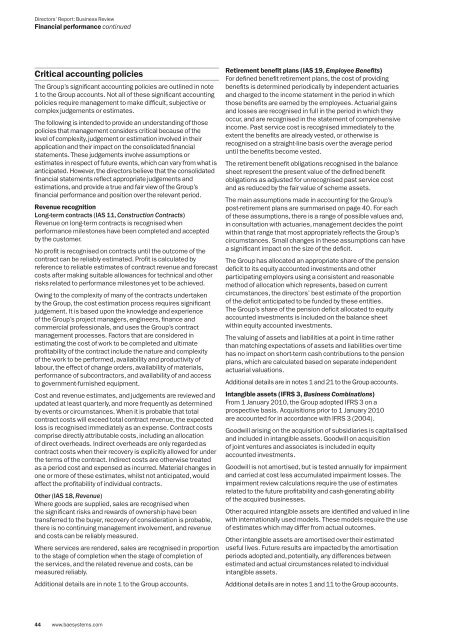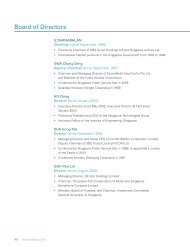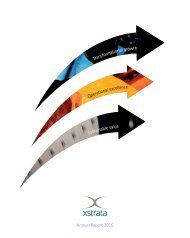Annual Report PDF - Black Sun Plc
Annual Report PDF - Black Sun Plc
Annual Report PDF - Black Sun Plc
You also want an ePaper? Increase the reach of your titles
YUMPU automatically turns print PDFs into web optimized ePapers that Google loves.
Directors’ <strong>Report</strong>: Business ReviewFinancial performance continuedCritical accounting policiesThe Group’s significant accounting policies are outlined in note1 to the Group accounts. Not all of these significant accountingpolicies require management to make difficult, subjective orcomplex judgements or estimates.The following is intended to provide an understanding of thosepolicies that management considers critical because of thelevel of complexity, judgement or estimation involved in theirapplication and their impact on the consolidated financialstatements. These judgements involve assumptions orestimates in respect of future events, which can vary from what isanticipated. However, the directors believe that the consolidatedfinancial statements reflect appropriate judgements andestimations, and provide a true and fair view of the Group’sfinancial performance and position over the relevant period.Revenue recognitionlong-term contracts (ias 11, Construction Contracts)Revenue on long-term contracts is recognised whenperformance milestones have been completed and acceptedby the customer.No profit is recognised on contracts until the outcome of thecontract can be reliably estimated. Profit is calculated byreference to reliable estimates of contract revenue and forecastcosts after making suitable allowances for technical and otherrisks related to performance milestones yet to be achieved.Owing to the complexity of many of the contracts undertakenby the Group, the cost estimation process requires significantjudgement. It is based upon the knowledge and experienceof the Group’s project managers, engineers, finance andcommercial professionals, and uses the Group’s contractmanagement processes. Factors that are considered inestimating the cost of work to be completed and ultimateprofitability of the contract include the nature and complexityof the work to be performed, availability and productivity oflabour, the effect of change orders, availability of materials,performance of subcontractors, and availability of and accessto government-furnished equipment.Cost and revenue estimates, and judgements are reviewed andupdated at least quarterly, and more frequently as determinedby events or circumstances. When it is probable that totalcontract costs will exceed total contract revenue, the expectedloss is recognised immediately as an expense. Contract costscomprise directly attributable costs, including an allocationof direct overheads. Indirect overheads are only regarded ascontract costs when their recovery is explicitly allowed for underthe terms of the contract. Indirect costs are otherwise treatedas a period cost and expensed as incurred. Material changes inone or more of these estimates, whilst not anticipated, wouldaffect the profitability of individual contracts.other (ias 18, Revenue)Where goods are supplied, sales are recognised whenthe significant risks and rewards of ownership have beentransferred to the buyer, recovery of consideration is probable,there is no continuing management involvement, and revenueand costs can be reliably measured.Where services are rendered, sales are recognised in proportionto the stage of completion when the stage of completion ofthe services, and the related revenue and costs, can bemeasured reliably.Additional details are in note 1 to the Group accounts.Retirement benefit plans (IAS 19, Employee Benefits)For defined benefit retirement plans, the cost of providingbenefits is determined periodically by independent actuariesand charged to the income statement in the period in whichthose benefits are earned by the employees. Actuarial gainsand losses are recognised in full in the period in which theyoccur, and are recognised in the statement of comprehensiveincome. Past service cost is recognised immediately to theextent the benefits are already vested, or otherwise isrecognised on a straight-line basis over the average perioduntil the benefits become vested.The retirement benefit obligations recognised in the balancesheet represent the present value of the defined benefitobligations as adjusted for unrecognised past service costand as reduced by the fair value of scheme assets.The main assumptions made in accounting for the Group’spost-retirement plans are summarised on page 40. For eachof these assumptions, there is a range of possible values and,in consultation with actuaries, management decides the pointwithin that range that most appropriately reflects the Group’scircumstances. Small changes in these assumptions can havea significant impact on the size of the deficit.The Group has allocated an appropriate share of the pensiondeficit to its equity accounted investments and otherparticipating employers using a consistent and reasonablemethod of allocation which represents, based on currentcircumstances, the directors’ best estimate of the proportionof the deficit anticipated to be funded by these entities.The Group’s share of the pension deficit allocated to equityaccounted investments is included on the balance sheetwithin equity accounted investments.The valuing of assets and liabilities at a point in time ratherthan matching expectations of assets and liabilities over timehas no impact on short-term cash contributions to the pensionplans, which are calculated based on separate independentactuarial valuations.Additional details are in notes 1 and 21 to the Group accounts.Intangible assets (IFRS 3, Business Combinations)From 1 January 2010, the Group adopted IFRS 3 on aprospective basis. Acquisitions prior to 1 January 2010are accounted for in accordance with IFRS 3 (2004).Goodwill arising on the acquisition of subsidiaries is capitalisedand included in intangible assets. Goodwill on acquisitionof joint ventures and associates is included in equityaccounted investments.Goodwill is not amortised, but is tested annually for impairmentand carried at cost less accumulated impairment losses. Theimpairment review calculations require the use of estimatesrelated to the future profitability and cash-generating abilityof the acquired businesses.Other acquired intangible assets are identified and valued in linewith internationally used models. These models require the useof estimates which may differ from actual outcomes.Other intangible assets are amortised over their estimateduseful lives. Future results are impacted by the amortisationperiods adopted and, potentially, any differences betweenestimated and actual circumstances related to individualintangible assets.Additional details are in notes 1 and 11 to the Group accounts.44 www.baesystems.com











